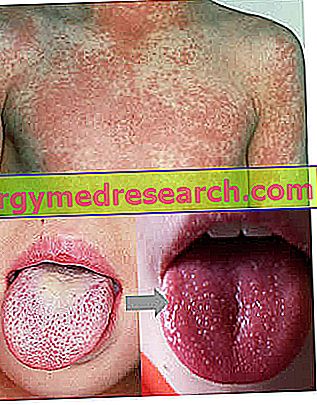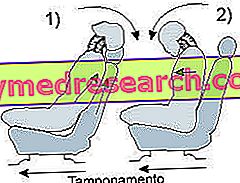Generality
Scarlet fever is an acute infectious disease, due to the group A beta-hemolytic streptococcus bacterium and responsible for a characteristic scarlet-red exanthema.

In addition to the scarlet-red exanthema, to complete the symptoms of scarlet fever are: fever, sore throat, abdominal pain, tachycardia, headache, white strawberry tongue (at an early stage of the disease), widespread furfuraceous desquamation (in a late phase of the disease) and raspberry tongue (also in a late phase of the disease).
In general, the diagnosis of scarlet fever is based on the physical examination, that is on the evaluation of the symptoms and of the signs complained by the patient. In the presence of any doubts, the use of the pharyngeal swab is decisive.
The treatment involves a drug therapy based on antibiotics, for at least 7-10 days, and bed rest, for as long as there is fever.
With adequate therapies, the prognosis is generally positive.
What is scarlet fever?
Scarlet fever is an acute infectious disease of bacterial origin .
Epidemiology
Scarlet fever mainly affects children between the ages of three and twelve; it is rare, but still possible, in adults and infants.
Its diffusion in both sexes is almost the same, demonstrating that there is no predisposition to the disease in question by males or females.
To learn more: Scarlet fever in children »
Causes
The cause of scarlet fever is a bacterium that produces erythrogen toxins, called group A beta-hemolytic streptococcus .
Group A beta-hemolytic streptococcus owes its notoriety not only to the fact that it is the infectious agent of scarlet fever, but also to the fact that it is at the origin of many episodes of throat infection and skin infection.
CONTAGUE AND TRANSMISSION
In scarlet fever, the infection is direct and occurs through the droplets of saliva, which the sick emit with coughing, sneezing, breathing or when they talk, especially in the first days of infection.
Scarlet fever can also be transmitted through contaminated objects (for example, toys, books, clothes, cutlery, glasses, etc.), thanks to the long survival capacity in the environment, enjoyed by the group A beta-hemolytic streptococcus.
In the absence of adequate antibiotic therapy, which eliminates the degree of infectiousness after 24-48 hours, the risk of transmitting the infection remains throughout the duration of the disease.
Symptoms and complications
To learn more: Scarlattina symptoms
The characteristic cutaneous manifestations of scarlet fever are due to the blood spread (ie in the blood) of bacterial toxins; the onset is sudden and violent: after two or three days from the infection, the feverish patient complains of abdominal pain, tachycardia, headache and throat pain . The tonsils are hypertrophic and, similar to the tongue, can become covered with a whitish patina. Swallowing is painful .
One of the most common symptoms is bacterial pharyngitis .
Equally typical is the onset, within 12-48 hours, of a scarlet-colored rash (hence the name "scarlattina"), characterized by the appearance of dots and red spots very close to each other and slightly raised, which vanish to the touch leaving the yellow imprint of the hand. This rash generally appears at the level of the neck, near the armpits and in the groin area, and then extends to the entire body surface within 24 hours; the only anatomical areas that save are the nose, the mouth and the chin.
Foto Scarlattina

See other Scarlattina Photos
After a few days, the rash - which never has an itchy nature - disappears and gives way to a widespread furfuraceous desquamation, which, starting from the face, is disseminated on the trunk, limbs and extremities (ie hands and feet), where it becomes particularly evident ( lamellar desquamation ). Overall, the aforementioned desquamation process can last several days.
Another characteristic symptom is the presence of a whitish patina on the tongue, which appears shortly after the onset of the disease and from which distinct red and edematous papillae emerge. This manifestation is commonly known as " white strawberry tongue ".
A few days later, the aforementioned white patina on the tongue begins to change and, due to a process of desquamation, it turns red and takes on an obviously wrinkled appearance. In general, to describe the aforementioned new red and wrinkled appearance of the tongue, doctors use the term " raspberry tongue ".
In the milder forms of scarlet fever, the symptom picture above is attenuated, the rash is very modest and fever and other symptoms can be almost absent. In such situations, one speaks more properly of " scarlatinetta " or " fourth disease ".
Table. Symptoms and typical signs of scarlet fever:
- Sore throat;
- Fever (around 38 ° C);
- White strawberry tongue (ie white), in the very first days of the illness;
- Raspberry tongue (ie red), a few days after the onset of the disease;
- Widespread rash (or rash), characterized by dots and red spots very close to each other. It is not itchy, it affects the whole body a little and, after a few days, a typical desquamation gives way;
- Abdominal pains;
- Tachycardia;
- Headache.
COMPLICATIONS
Before the advent of the so-called "penicillin era", scarlet fever could cause death and become the protagonist of various complications, including meningitis, septicemia, encephalitis, endocarditis, rheumatic disease and glomerulonephritis.
Today, thanks to the wide availability of antibiotics, death and the aforementioned complications are fortunately rare.
Diagnosis
The diagnosis of scarlet fever is clinical, for the full-blown forms; it is based, instead, on the positivity to the pharyngeal swab, for the mild forms.
CLINICAL DIAGNOSIS
The diagnosis of a disease is clinical, when it is based on the investigation and evaluation of symptoms and signs, manifested by the patient. In medicine, the investigation and evaluation of the present symptomatology takes the specific name of objective examination .
In the case of individuals with suspected scarlet fever, the physical examination mainly involves the observation of the throat, tongue, tonsils and skin, with the aim of detecting any abnormal signs (eg: white patina on the tongue, rash, etc. .).
FARINGEO BUFFER
The pharyngeal swab is a diagnostic test that allows to clarify, definitively, if a certain suffering of the throat is linked or not to a determined pathogenic microorganism.
Briefly, it involves rubbing the tonsils and pharyngeal mucosa with a special cotton bud, in order to take some cells and analyze them later in the laboratory.
In the case of scarlet fever, the pharyngeal swab represents a fundamental test in all those dubious or equivocal circumstances (eg: modest exanthema, fever and other typical symptoms absent or just mentioned).
Therapy
Scarlet fever treatment involves the early administration of antibiotics, for at least 7-10 days, and bed rest, as long as a fever is present.
The first choice antibiotics are oral penicillins or, if the patient is allergic to the latter, the macrolides .
During the first days of the illness, it is good practice to resort to the isolation of the patient, especially if it is a child, to avoid transmission of the infection to family members and peers (eg: classmates, playmates, etc.).
Regarding the isolation of the young scarlet fever patient, Italian law is clear and provides for readmission to school after 2 days from the start of antibiotic therapy. In fact, several scientific studies have found that a child with scarlet fever, after 24 hours from the start of antibiotic administration, is still contagious.
Continue: Medicines for Scarlet Fever Treatment »
AN INDIVIDUAL STRUCK IN THE PAST WAY TO SCARLATTINA CAN DAMAGE YOU AGAIN?
Since there are several strains of group A beta-hemolytic Streptococcus, you can get sick of scarlet fever several times.
SCARLATTINA AND PREGNANCY: HOW TO WORK?
Most scientific and clinical studies have shown that getting sick from scarlet fever during pregnancy is not generally a danger to the fetus. However, it is still a good idea for pregnant women, who contract scarlet fever, to immediately contact their primary care physician and gynecologist, to indicate the most appropriate therapy for the case.
OTHER WAYS TO RELIEVE SYMPTOMS
To optimize the effects of antibiotic therapy in scarlet fever, doctors recommend:
- Administer a painkiller, such as ibuprofen or acetaminophen, in the presence of severe throat pain or high fever;
- Continuously guaranteeing fluids (water in particular), to reduce the possibility of dehydration due to the presence of fever;
- Humidify the air in the room where the patient is staying, during the illness. Dry air can further irritate the already sore throat;
- Perform or have performed, if the patient is an inexperienced young person, gargle with salt water . Gargle with salt water soothes sore throats;
- Make available to the patient foods that are relief to the throat, such as hot soups or ice lollies;
- Avoid the release of irritants (eg cigarette smoke) in the room that houses the patient and, in general, in the entire home.
Prognosis
In most cases where the therapy is timely and adequate, scarlet fever resolves positively within a few days.
In the absence of appropriate antibiotic treatment, the infection in question could last up to 2 weeks. Moreover, in these situations, there is a concrete risk of complications.
For optimal healing, it is essential to follow the doctor's instructions regarding antibiotic therapy; in fact, transgressing these indications (eg: interrupting the therapies first, because the patient shows significant improvements) can lead to relapse.
Prevention
Currently, no vaccines are available to prevent scarlet fever.
This does not exclude, however, that precautions and precautions exist that can reduce the risk of contracting scarlet fever.
Among the precautions and precautions that involve a reduction of the scarlet fever risk, are:
- Accurate hand washing . Hands are one of the main sources of germs and bacteria, including the bacterium that causes scarlet fever. Parents should instruct their children on how to wash their hands properly (soap, warm water, etc.) and how hand washing is an ideal hygienic rule, to avoid possible infections;
- Avoid sharing cooking utensils and food . As a general rule, children should never share cutlery, glasses and food with each other. To justify this foresight is the fact that many bacterial agents survive for a long time on the objects contaminated by them;
- Cover your nose and mouth in case of sneezing or coughing . This is explained by what was stated above regarding the transmission of scarlet fever: sneezing and coughing represent two modes of infection;
- Provide for the cleaning of everything an individual with scarlet fever may have touched.



